The Women Designers Who Changed The Way We Dress
In the August issue of Vogue, our colleague Sarah Mower writes passionately about the women designers leading fashion today. Their achievement, she argues, “amounts to a reshaping of the industry—not by fitting in with male-led corporate rules but by steadily ignoring them, trusting their own instincts, living how they wish, and opening wide the creative space for a whole generation to thrive.” It sounds like a manifesto for the 2020s, doesn’t it?
We conceived of this as a companion piece to Sarah’s persuasive essay. It’s an examination and a celebration of designers who’ve changed the way we dress, from Rei Kawakubo and Miuccia Prada, both of whom rejected the pretty in favor of the beautiful; to Stella McCartney and Eileen Fisher, our designer environmentalists; to Phoebe Philo and Rodarte’s Kate and Laura Mulleavy, who embody opposite ends of the minimal-maximal divide. Iconoclasm comes in many forms.
Though it’s not comprehensive—there’s no Coco Chanel, Madeleine Vionnet, nor any other of the great names no longer with us on the list because we kept our focus on the women who shaped fashion from 1980 onwards—it does represent the passions and preoccupations of the editors and contributors of Vogue.

Miuccia Prada
The evolution of women’s fashion in the 20th century is largely a story of liberation—first from corsets, then from skirts, and finally from teetering stiletto heels. The one mantle we struggled to shake off for the better part of the century was that of prettiness. Miuccia Prada changed that with a swift pivot of her chunky heeled loafer. Her Spring 1996 collection was a celebration of all the things fashion once considered ugly, from upholstery prints to putrid, acid colors to square-toed, T-strap shoes. By Mrs. Prada’s own admission, “Ugly is attractive, ugly is exciting. Maybe because it is newer. The investigation of ugliness is, to me, more interesting than the bourgeois idea of beauty.”
The jolie laide of Prada’s “ugly prints” collection, as it came to be known, changed the look of the late ’90s. Anywhere there was a worthwhile art fair, champagne-fueled book signing, or indie film screening, there was also an army of Prada-clad women in thick glasses, groovy prints, and the heaviest of shoes. Since then, Mrs. Prada has found hundreds of more ways to render what is traditionally considered outré attractive. She has paired midi skirts with lug-soled brogues. She has clashed babydoll tops with board shorts. She has advocated, fiercely, for socks with sandals, nubbly wool tights, and body-hiding nylon puffas, while simultaneously creating sexy little scarf dresses, Josephine Baker miniskirts, and housewife frocks with pointed busts.
Anything, without presumption, can be Prada-fied, from lipstick canisters to classic cars, from Belle du Jour to Frankenstein. In that, it’s a celebration of clothes over fashion, of style over trends. The thing Mrs. P is responsible for liberating us from? Rules themselves. — Steff Yotka

Donatella Versace
As much as I despise the use of the word iconic in fashion, there is one woman designer for whom there is no other adequate description. Donatella Versace is revered as a gay icon, as a feminist icon, as a personage whose image can be so easily conjured that only her first name is necessary for her to spring to the mind’s eye in all her blonde glory.
Donatella’s appeal—her fame transcends the confines of the fashion bubble—is a many-faceted, flashy, funny, facetious, life-enhancing thing. All the more lovable for the knowing way she stiletto-teeters on her platforms between extreme confidence and humorous fallibility, she has succeeded by transforming herself into a contradiction: a 100 percent genuine fake.
For Gen Z fans for whom the ’90s are a golden-tinted fantasyland, Donatella’s iconhood must appear, wonderfully, reassuringly, to have pre-existed forever, since long before they were born. In fact, it was created by her out of tragedy, the dazzling armor she painted and burnished to defend the Versace family business in the years after the murder of her brother Gianni in 1997.
That shocking story is so often retold and fictionalized that it has itself somehow become an unreal part of pop culture—except, surely, for the family. Gianni Versace was a giant of design, color, print, sexiness—the antithesis to the gray sobriety of Giorgio Armani. A dramatic stylistic standoff between the two made Milan the most exciting capital of fashion. But I’ve thought that what the legend of Gianni has always tended to overshadow is how much his kid sister Donatella was instrumental in forging the foundations of the house. No passive pet muse, she was the one who went out and made the relationships with the rockstars and rappers, who brought people who were about to be major in to perform and collaborate. (I still treasure a giveaway Versace cassette tape by Prince—Prince!) She amped up the celebrity quotient of the Versace front row, and she was who made friends with all the supermodels: Linda, Christy, Naomi,Cindy, Shalom, Amber—everyone!
That caused an explosion in fashion history, a watershed in the way its communication would cascade on ’til this very day. We know that those years came at a cost to Donatella: the Italian rockstar, the nonstop party hostess with the mostest. She was one of the first in fashion to find redemption in rehab and yet not suffer public vilification for it. This, too, has contributed to giving her iconography a human and vulnerable aspect. Donatella, the survivor, a figure to pray to for hope.
Another important characteristic that shone out all along is what an internationalist Donatella is—not by any means the norm in the Italian fashion culture. As a longtime supporter of gay rights, AIDS activism, sisterhood, and diversity, she’s never wavered in normalizing, nay, glamorizing equality.
Meanwhile, what a promoter of youth and fun is she? Over the years, she’s filled her studios with talented graduates and upstarts. Christopher Kane, Jonathan Anderson, Michael Halpern, and many others have revolved through the doors of the house, whether designing Versus or inputting alongside her longtime Italian experts.
For all this, Donatella Versace, in all her vitality, her perseverance, her hilarious self-parodic fabulousness is rightly revered. With her high-rolling years behind her, she’s never turned into a prim mamma, either. Adored as she is by kids, she’s also, I might say, an inspiration to her own generation. Look at her, and you know, despite everything, there’s still fun to be had in the world. — Sarah Mower

Maria Grazia Chiuri of Dior
When Maria Grazia Chiuri was named creative director of Christian Dior in July 2016, the first woman to lead the storied house, her place in fashion history was secure. But her influence had already infiltrated fashionable wardrobes the world over. She was part of the accessories design team at Fendi when the “baguette” — the It bag of It bags—was born. And with Pierpaolo Piccioli for Valentino, she helped bring modesty of a most opulent stripe to the red carpet.
Her debut for Dior featured message tees that boldly stated, pre-#MeToo, “we should all be feminists,” a literal reference to the writing of Chimamanda Ngozi Adichie and a sartorial nod to another female design pioneer Katharine Hamnett. She mixed these tees with looks that nodded to fencers and ballerinas, and a new Dior woman emerged: sturdy yet delicate, with a fighting spirit and a romantic hinterland (Chiuri’s woman loves both real world politics and the mystical tarot). It’s a character embodied in Chiuri’s most signature shoe design for the brand: a pointy slingback, flat or kitten-heeled, secured by a ribbon. It’s a wisp of a shoe, a beauty, but one that empowers the wearer to walk for miles with comfort and joy. — Sally Singer

Rei Kawakubo of Comme des Garçons
“I work in three shades of black,” Comme des Garçons founder Rei Kawakubo once said, but the legions of women who have been enthralled and inspired by her clothes might beg to differ—she employs far more versions of black than a mere three. The revolutionary Kawakubo, who burst on the scene half a century ago, was hell-bent on upending conventional notions of attractiveness, arguing, “for something to be beautiful it doesn’t have to be pretty.… Comme des Garçons is a gift to oneself, not something to appeal or to attract the opposite sex.” (These are by the way, among the designer’s very few statements on the record—the designer is legendarily taciturn, preferring to let her work speak for itself.)
The press dubbed her customers, swathed in their voluminous deconstructed Comme fashions, “the crows.” But no matter—these birds knew that there was true liberation lurking in these unusual fashions. Kawakubo used polyester, left seams frayed, and added lumps and holes. She blurred the lines between masculine and feminine tropes in a single garment; she flattened dresses so that they seemed suited for paper dolls. Eventually, she added bright colors and even prints, but no matter how raucous the material, the clothes kept their strange seductive austerity.
In 2017, the Metropolitan Museum of Art celebrated Kawakubo with an exhibition entitled, “Rei Kawakubo/Comme des Garçons, Art of the In-Between.” The show was designed as an austere, all-white maze and presented approximately 150 Comme ensembles. Andrew Bolton, the curator for the Met show, stated: “I really think her influence is so huge, but sometimes it’s subtle.… It’s the purity of her vision.” — Lynn Yaeger
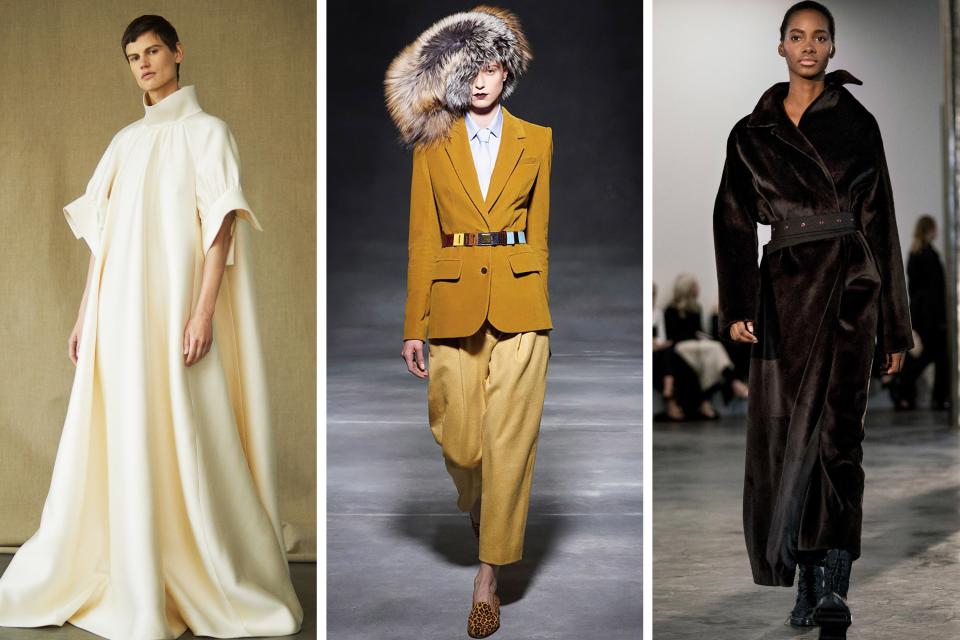
Ashley and Mary-Kate Olsen of The Row
Way back in 2007 Ashley and Mary-Kate Olsen launched The Row off the back of a tee, and theirs was done to a T: angel’s breath soft cotton, the right drape, and an inner construction that was finished with expensive and exquisitely rendered French seams. Okay, here’s the question that immediately springs to mind: Who on earth uses French seaming, a technique that was last seen back when models did runway shows with numbered cards in their hands, for a (now not so) humble shirt? The Olsens, that’s who. It matters not a jot that only you and they knew it had been made that way. In fact, that was the whole point, and in essence it’s the ever-beguiling appeal of what these sisters do: take clothes of relatively quotidian origins—the crewneck sweater, the smoking, the belted robe coat, pants cut with precision and slouch in equal measure—and transport them to Closet Nirvana by making them in ways which are as luxurious as they are understated. Long before we talked of value, of longevity, of retaining not discarding, the Olsens were articulating those very things.
By doing so, they emerged as the surprising champions of a whole constituency of women who, in that post-Jil pre-Phoebe moment, had been disenfranchised by the movement towards fashion as fashion and not fashion as clothes. The Olsens hinted they were of the same mind: Their first runway show, for Fall 2010, cemented their signature exquisitely minimalist tailoring, but after it they vowed off doing another for a while; too fashion. They’re now back on the runway, on their own terms, and they’re pushing supersize volumes with a very American approach to craft and construction that evokes Beene or Zoran. But some things don’t change: By reaching into the past to perfect their clothes, they simply convince us of their relevance to the future. — Mark Holgate
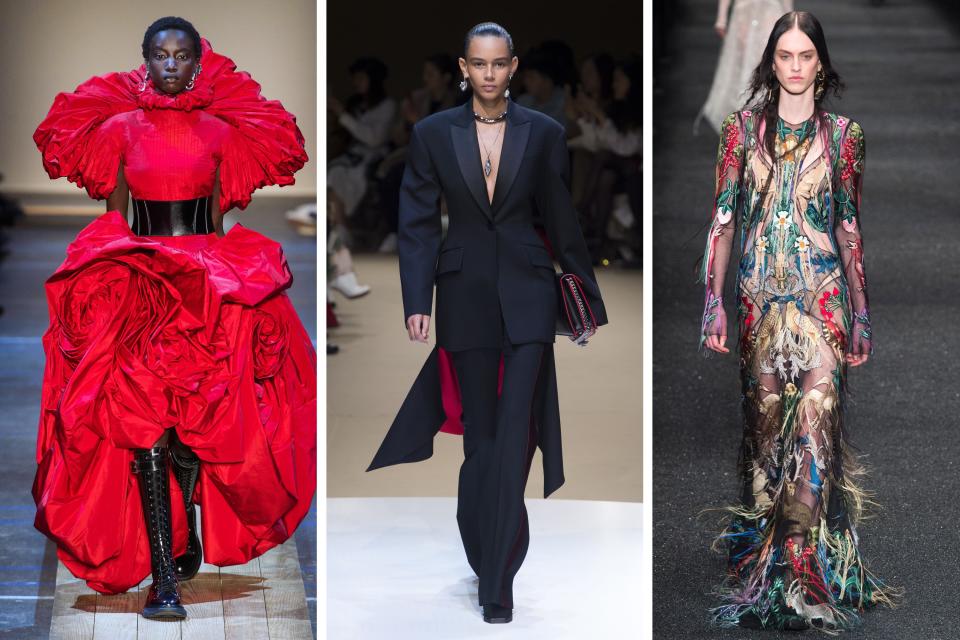
Sarah Burton of Alexander McQueen
Sarah Burton rose to the fore in the saddest of circumstances: The death of Lee McQueen in February 2010 led, two months later, to the then-PPR group’s naming of her as his successor at the house he had founded in 1992. Burton had joined Alexander McQueen in 1996, first as an intern, then as his personal assistant, before rising in 2000 to head of womenswear.
In the time since, Burton has been not only a diligent keeper of the McQueen flame but also an enhancer of it. On her watch, certain elements of the original McQueen signature—the beautifully dramatic but also painful expressions of cruelty and control that were a product of McQueen’s own troubled relationship with the world around him—have been refashioned to become no less radical but markedly more feminocentric. Burton’s commission to dress The Duchess of Cambridge for her wedding in April 2011 in a silk satin gown tapestried by The Royal School of Needlework was a key punctuation mark in this new chapter. Its strongest expression, however, has played out on Burton’s runways: In her hands, the McQueen DNA has been resequenced via technical precision and creative playfulness to bring alive a hyper-feminine and spiritual sense of British heritage—sometimes pagan, sometimes industrial—that plays across the centuries. Burton told Vogue Runway earlier this year: “Lee always said to me, “You have to make things your own, you have to believe in it, and it has to be an emotional thing, what we do.” She has done that by making Alexander McQueen an exquisite source of strength and beauty for 21st-century Orlandos who refuse to be bound by the now. — Luke Leitch

Stella McCartney
When Stella McCartney debuted her fur- and leather-free collection in 2001, she faced plenty of skepticism: How could a designer possibly build a business without luxury leather goods? Her now-signature Falabella bag proved precisely how. Fast forward to 2019, and not only has McCartney become known for those non-leather goods and her playful, sporty ready-to-wear, but she’s inspiring a generation of women to consider the environmental impact of what they buy. McCartney was way ahead of the current sustainability movement when she suggested that fashion shouldn’t just be about how we look; it should be about how our choices relate to the planet and people around us.
She’s become increasingly vocal in the last few years, adjusting her focus to include sustainability from every angle, not just animal cruelty. With her successful Adidas x Stella McCartney collaborations, she’s brought recycled polyester to the athletic market, and on the runway, she uses upcycled materials, experiments with vegetable-based “leather” and “silk,” and utilizes fully-traceable fibers like alpaca (significantly more eco-friendly than cashmere). Even the wedding dress McCartney designed for Meghan Markle’s reception was made with viscose, a fluid material made from wood pulp.
Still, after two decades in business and in the midst of a climate crisis, McCartney remains an outlier. She isn’t daunted, though; in fact, she’s getting more radical. In a recent campaign, she enlisted women from the climate activist group Extinction Rebellion, and she’s still the only designer who has encouraged people to consign their used designer items through The RealReal. In a Vogue.com story published earlier this year, she spoke candidly about the lack of progress from her designer peers: “I just think it’s time to man up and have an element of honesty. I do need a few more colleagues linking my arm and standing shoulder to shoulder with me, because that’s how we can make significant change.”
If they weren’t paying attention then, they are now: Last month, LVMH took a minority stake in McCartney’s brand, and the luxury group is serious about ramping up its sustainability efforts. Also, chief executive Bernard Arnault named McCartney to LVMH’s executive committee as his special advisor. Now that she has the ear of one of fashion’s most powerful leaders, we can expect even more action from McCartney—and, hopefully, a wave of designers who are finally ready to follow her lead. — Emily Farra
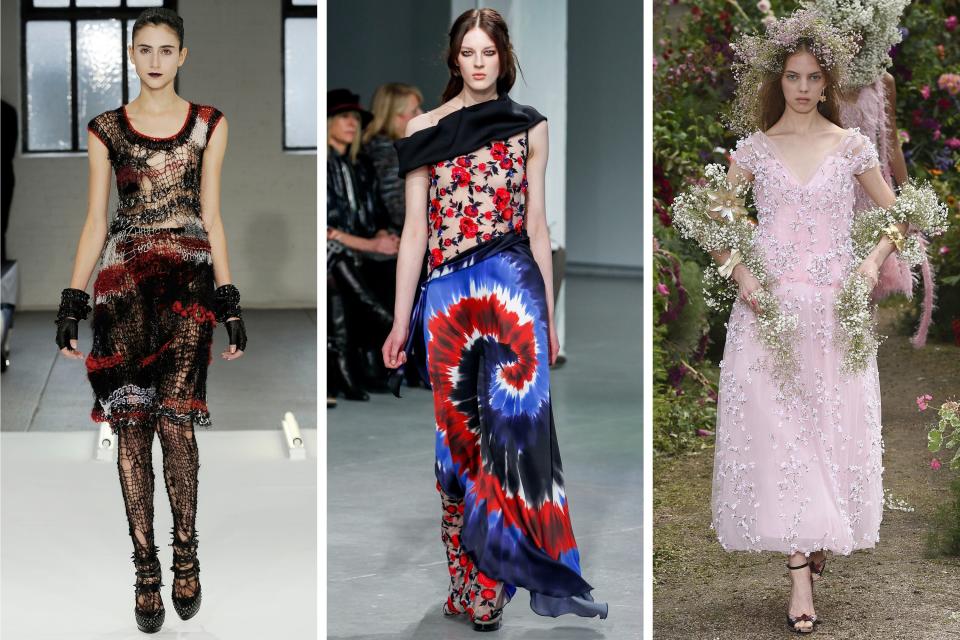
Kate and Laura Mulleavy of Rodarte
Since 2005, Kate and Laura Mulleavy’s label Rodarte has been the standard-bearer for ferocious independence and fantastical beauty for an industry too often concerned with anything but. Rodarte has remained based in Los Angeles, shown only twice a year (and not always on a runway), and the Mulleavys’ designs are never mundane or mere wardrobe filler—unless one’s idea of basic includes leather-ruffled, fully sequined party dresses or dotted Swiss tea gowns. For fashion consumers their influence is gestural and aspirational: They made it okay to wear artistically laddered tights, wildly loose gauge knits, satin baseball jackets, the spikiest gladiators, point d’esprit for day, baby’s breath for big events. For women everywhere, however, their leadership extends beyond their actual designs. They write and direct feature films; they collaborate on operas, ballets, and museum shows; and they run a business in which they create the clothes of their dreams and not merely a wardrobe for themselves. The Mulleavys have consistently protected their ability to be artists as well as businesswomen, and to be recognized as both on their own terms. Take note. — S.S.
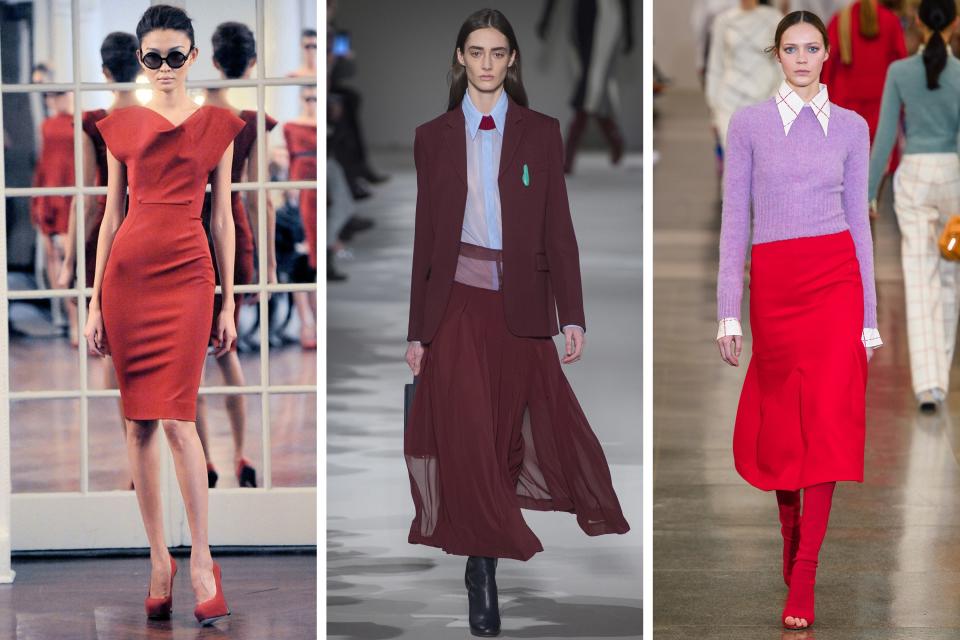
Victoria Beckham
As the cautionary tale of Lindsay Lohan at Ungaro illustrates, the transition from being famous for something else to becoming a famous fashion designer is a path fraught with peril. Yet at around the same time as Lohan, about a decade ago, Victoria Beckham—aka Posh Spice—was navigating the opening meanders of the same path with aplomb. By launching her label in New York rather than on her British home turf, she astutely distanced herself from domestic snobbery. And by presenting her first few seasons via intimate meetings with editors and buyers—in which she demonstrated herself as simultaneously modest, funny, self-deprecating, and determined—Beckham rapidly charmed away any in-industry cynicism.
From the start she said she wanted to learn on the job (and paid free tribute to inspirations and supporters such as Tom Ford and Marc Jacobs), and her collections have reflected that. The gold-zippered body-con of her first has flowered over time into a sophisticated expression of the considered, jet-set life she leads, and which is reflected in the wants of her customer. There is no doubt her status as a fashion designer has been achieved, in part, both despite and because of her Spice Girls–marinated celebrity. She is also a successful female fashion designer, period. By pursuing her ambition with hard work, she has achieved that ambition: Girl Power. —L.L.
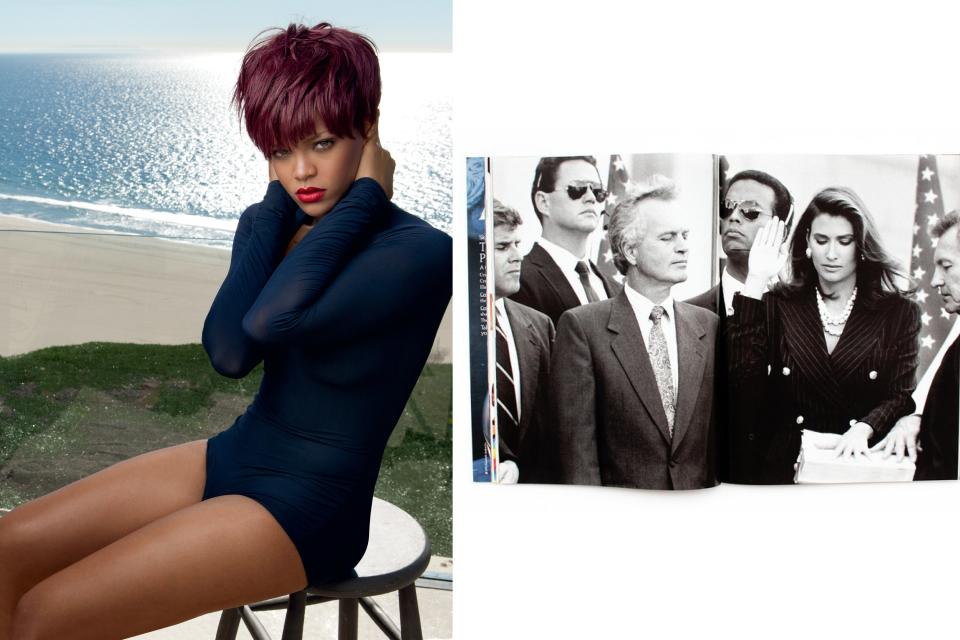
Donna Karan
In today’s era of comfort and athleisure, it’s fair to assume that most designers wish they’d been the ones to come up with the “Seven Easy Pieces” concept pioneered by Donna Karan. Introduced in 1985, the capsule of basics—a bodysuit, a wrap skirt, a tailored jacket, a simple dress, a white shirt, a cashmere sweater, and a leather jacket—was ingeniously simple, but came to represent so many things. For starters, it was true “solution dressing” for women who needed to look elegant from morning ’til night, no outfit change required (just add or subtract a piece if necessary.) The Seven Easy Pieces were also Karan’s sultry, curve-skimming answer to the boxy suits she’d seen women wear in an attempt to look “professional.” In 2016, she told Vogue: “Every woman [back then] was dressing like a man. She was walking down the street in a shirt, tie, and suit because that’s a ‘businesswoman.’ I said, ‘That’s not a woman.’ A woman is her body, her sensuality, and her tailoredness, so I combined them together.”
Nearly 35 years later, none of those pieces feel outdated or passé; in fact, bodysuits are more popular than ever (brands like Alix are specifically dedicated to them), and though tailoring has leaned toward those oversized ’80s proportions of late, girls aren’t wearing them with pooling trousers. They’re wearing them with leggings or bike shorts—the same ones they wear to Pilates. Wellness and sport were major influences for Karan’s Seven Easy Pieces, too; she was practicing yoga decades before it was trendy, and more or less predicted our current gym-to-brunch lifestyle.
Karan’s mission to “dress and address” her women’s needs has always gone beyond the clothes, too. In 1992, she launched a now-iconic ad campaign that showed model Rosemary McGrotha being sworn in as the first female president, dressed in a pinstriped suit and giant pearl necklaces. At the time, it registered as a bold display of feminism and empowerment. Today, the image still conveys “power dressing”—suits are still the go-to for most female politicians. Of course, it feels even more poignant in the wake of Hillary Clinton’s loss in the 2016 election. (Karan and her team likely didn’t think we’d still be talking about this 27 years later; surely by now we would have a real-life female president to celebrate).
In 2007, Karan changed course a bit and launched Urban Zen, a “lifestyle brand” in every sense of the word: It has clothes, home goods, essential oils, and jewelry, and its stores function as community centers for wellness-minded fans. Many of the housewares are made by artisans in Haiti, a country Karan has been supporting and advocating for since its devastating hurricane. Once again, she was ahead of her time, “connecting the dots” between fashion, philanthropy, wellness, and artisanal crafts. Urban Zen’s luxe-casual clothes share a similar spirit with those original Seven Easy Pieces. “I don’t want to think about clothes,” Karan said last year. “I just want to throw them on, feel good, and that’s it, day or night.” — E.F.
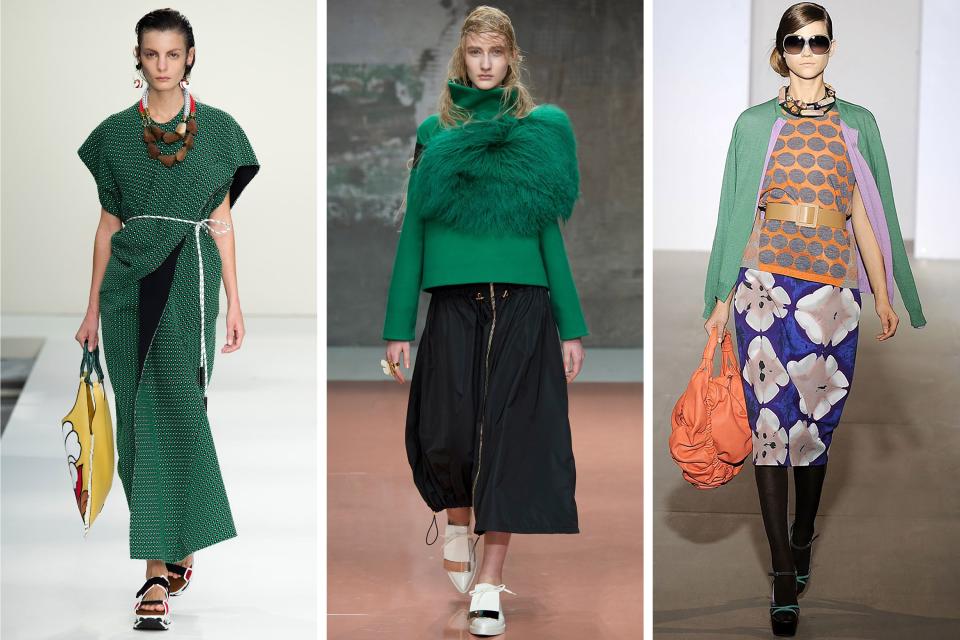
Consuelo Castiglioni of Marni
Is there a direct correlation between a designer’s quietness and her subversion? When it comes to Marni founder Consuelo Castiglioni, who headed the label from 1994 to 2016, you bet there is. After her shows, out she’d shyly bob for a blink-and-you’d-miss-her bow, and she wasn’t much more forthcoming when you went back to talk to her. But all that hardly mattered: When it came to the conversation between Castiglioni and the women who loved her clothes—women who refuted all the boring old notions and associations of femininity, luxury, and status as much as she did—it was an animated and impassioned dialog.
As Castiglioni morphed her Marni from pastoral Bathsheba Everdene innocence by way of hippie-trail bohemia to cardigan-ed debs with a mania for wearing as many Marimekko-like prints as was humanly possible to the late years of oversized layered athleticism, a gargantuan bag always to hand, one thing remained unchanged: the idea that individuality should triumph over uniformity and poeticism over power. Not that Castiglioni’s Marni never really lacked for the latter. If you ever succumbed to a Pop Art floral cotton tunic, piebald clogs, a chunky necklace with all the playfulness of a three year old’s toy, or a shaggy fur stole to wrap around a blanket coat, and many did, you’d been Marni-ed. And wasn’t life profoundly better for it? — M.H.
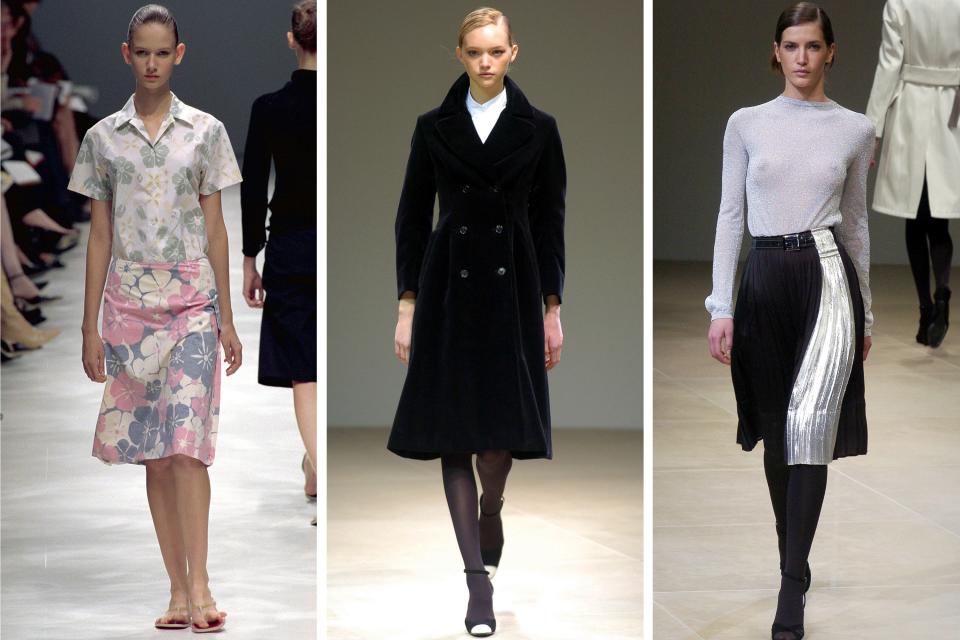
Jil Sander
On fashion’s continuum, Jil Sander sits between Giorgio Armani, who revolutionized menswear by loosening it up, and Phoebe Philo, whose return to minimalism in the 2010s was wholeheartedly embraced by a new generation of working women. Jil Sander had a cult following, too; the 1990s were her heyday. Though Craig McDean would conjure a grunge attitude in the campaign images he created for the brand in the early years of that decade, there was absolutely nothing scruffy about Sander’s designs, which balanced the rigor of tailoring with an almost sensuous obsession with luxury materials. (Her fellow German, Tomas Maier, shared these fixations with Sander.)
In an era in which “luxury” was the byword, Sander conjured it with subtlety, not via logos, as so many other leading labels of the time. “Pure can be rich and opulent, too,” she told Vogue in 1997. “The purer it gets, the more quality you need.” A high priestess of minimalism, Sander was her own best model because she understood—from experience—the needs of a high-powered working woman. — Laird Borrelli-Persson
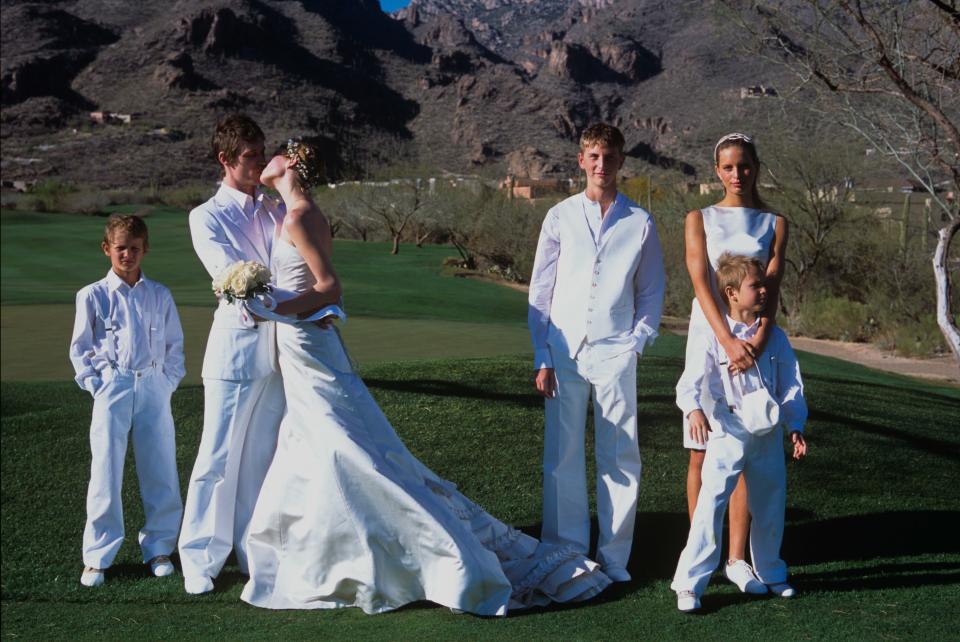
Vera Wang
In 1989, Vera Wang was searching for the perfect wedding dress. None of the pouf-skirted, lace frocks and modest styles with high necks and long sleeves she came across were her speed, so she sketched her own—a slinky, beaded slip dress—and brought it to a tailor to be made. A year and one walk down the aisle later, Wang’s bridal business was born.
From her boutique at the Carlyle Hotel, Wang single-handedly changed what women in America wear to say “I do.” She empowered her clients to try sexy wedding gown silhouettes, sheer backs, tightly fitted bodices, and low-cut necklines, and she sometimes whipped them up in unconventional colors like black, blue, and pink. Wang’s bridal collections brought her instant success, not only with the allure of her non-traditional, yet romantic gowns, but also via celebrity endorsements. Over the years, the former Vogue editor and design director of accessories for Ralph Lauren dressed the likes of Chelsea Clinton, Alicia Keys, Jennifer Lopez, and Mariah Carey (in a 27-foot train, no less) for their weddings.
After a decade spent transforming the bridal market, Wang launched her ready-to-wear business in 2000. Now, as she celebrates her company’s 30th anniversary, Wang is one of the world’s most recognized designers. Her contribution to fashion is simple: freedom of expression, whether for a walk down the aisle or a walk down the street. — Brooke Bobb
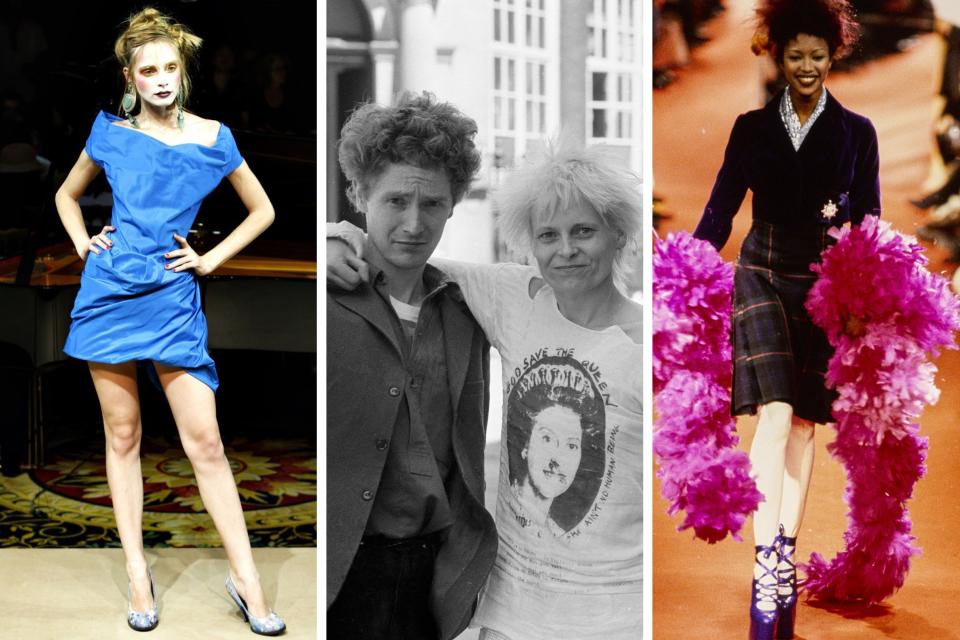
Vivenne Westwood
Since she arrived in London in the late 1960s, the always irreverent, sometimes thorny, frequently surprising Vivienne Westwood has captured the many ways in which a woman expresses herself through clothes—and her fashions have often been as irreverent, thorny, and surprising as their creator.
Westwood first became famous when she teamed up with Sex Pistols manager Malcolm McLaren, and together they launched the garments that the world would come to know as punk: “… punk fashion itself was iconographic: rips and dirt, safety pins, zips, slogans, and hairstyles,” she once declared. If these artfully distressed, finger-in-your eye fashions were all she had done, it would have been thrilling enough—but Westwood went on in the ensuing decades to offer clothes that relied on brilliant tailoring even as they made their rebellious points—collections with names like Savages (shown late 1981), Buffalo/Nostalgia Of Mud (shown spring 1982), Punkature (shown late 1982), and Worlds End (1984). Subsequent catwalks went on to channel young romantics, mock Sloane Rangers, and offer a twisted homage to the mini-crinis of Christian Lacroix.
Westwood may have spent almost half of a century providing generations of women with the kinds of clothes that made them feel chic yet rebellious, but she never lost her puckish charm. In 1992, on the occasion of receiving an OBE, she arrived at Buckingham Palace knicker-less, a decision documented by a photographer in the palace courtyard. Westwood later said, "I wished to show off my outfit by twirling the skirt. It did not occur to me that, as the photographers were practically on their knees, the result would be more glamorous than I expected.… I have heard that the picture amused the Queen.” — Lynn Yaeger
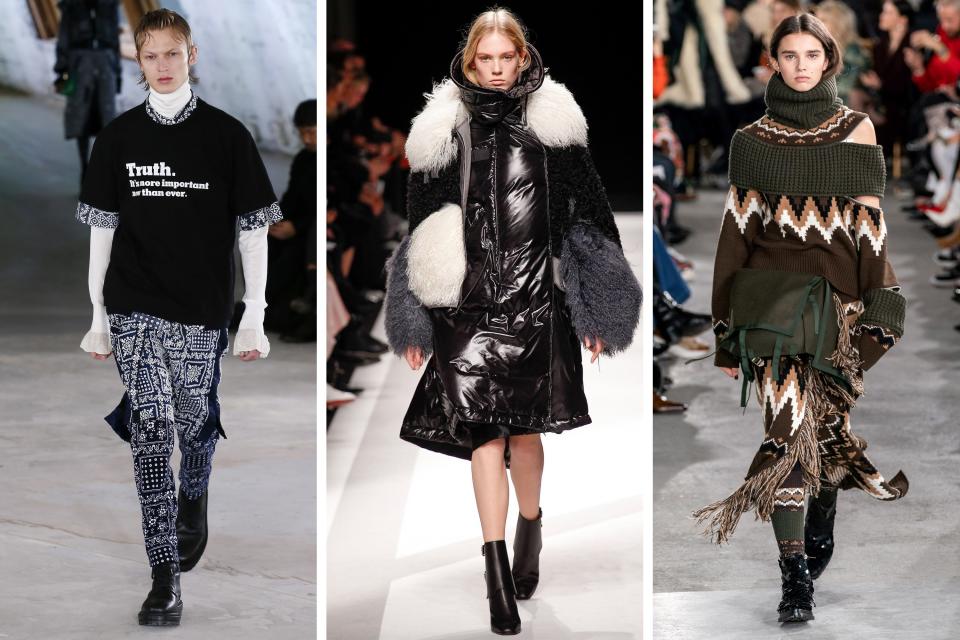
Chitose Abe of Sacai
If you’ve bought a sweater with a built-in button-down collar and hem, or worn a cotton T-shirt with a billowy silk back, you’ve experienced the Sacai effect. From her earliest days on the Paris catwalks, the Japanese designer Chitose Abe has specialized in mash-ups: Perfectos married to tweedy blazers, puffers fused to trad wool coats, cape-backed ponchos. Sounds wonky, but looks wonderful.
This isn’t complexity for complexity’s sake. Abe, whose accomplished, irreverent pattern-making is the result of foundational years in Comme des Garçons’s Tokyo atelier, understands on an intuitive level that there’s energy in her collisions. Masculine bumps up against feminine, and discipline mingles with freedom in her work, and the novelty and surprise of it is a turn-on. Indeed, Abe’s signature slicing and dicing have been copied up and down the fashion spectrum, but nobody remixes quite as well as she does. — Nicole Phelps

Katharine Hamnett
Let me take you back 30 years: It’s 1989, and Katharine Hamnett is living high on the London designer dream. Ten years into making her cool-sexy clothes and protest slogan T-shirts fashionable, she’s manufacturing in Italy, flying first class, being swished around in cars with blacked-out windows. She was beloved by George Michael and Frankie Goes to Hollywood, who’ve worn her T-shirts in music videos, and is a fearless young woman at the eye of the London pop-street-fashion culture whirlwind famous for confronting Margaret Thatcher with an anti-nuke T-shirt in 1984. Hamnett has Lynne Franks—the prototype for Edina in Absolutely Fabulous—as her PR; champagne is flowing at London parties every night, and yet, the designer is beginning to feel a bit blasé about the nonstop fun and the way the money almost seems to keep rolling in of its own accord.
At this—the very peak of the commercial hysteria around Hamnett—it crossed her mind that she might run an environmental investigation on the impact of her business. “It was just to check everything was okay, that we weren’t doing any harm—because my sister was a Buddhist,” she remembers. “And I discovered it was a living nightmare in all areas. Tens of thousands of farmers were, and still are, dying of pesticide poisoning in cotton agriculture. Millions of the same farmers were on the edge of starvation, being forced to borrow money to buy the chemicals that kill them.”
Realizing the cotton-farming horror was just the start of Hamnett’s epiphany on the road to turning her business towards “sustainability,” a new word to fashion ears in the early ’90s. Has there ever been a designer who chose the non-damaging route over the lure of profit and expansion the way Hamnett did? Her decisions meant canceling lucrative licenses, enduring years of being eye-rolled at as an outspoken woman campaigner bringing up human rights abuses, being the first to speak out about the damage caused by the production of denim and polyester, and once (as she’s paraphrased it) having an Italian manufacturer tell her, “If you carry on with this ethical and environmental shit, you can take your collection and fuck off.”
What if fashion had heeded Katharine Hamnett 30 years ago and followed her example? Surely the industry wouldn’t have stacked up the vast mess it’s in. But now, Hamnett’s time to be heard has truly come. Today, she’s a prophet vindicated, and a founding goddess in the eyes of the Extinction Rebellion generation. Her nonstop, practical activism and informed articulation of complex issues gets her invited onto more platforms and news shows at the age of 72 than ever in her entire career.
Now selling her clothes—several of which are are archival repeats—direct to the public (at least one or two advances of the past twenty years have been liberating) her choices of slogan T-shirts declare “GLOBAL GREEN DEAL NOW”; “CHOOSE LOVE” (the central Buddhist tenet she used in the ’80s, now sold to aid Help Refugees); “VOTE TRUMP OUT“; and “DON’T SHOOT,” for Black Lives Matter. Since children are leading climate emergency protests, she’s also added kids’ sizes reading “SAVE THE BEES,” “SAVE THE SEA,” and “SAVE THE FUTURE” (with proceeds going to the Environmental Justice Foundation.org).
Political slogan T-shirts might seem just part of the culture now, but it’s important to give Hamnett her due: It was she who set the typographical bold-capitals style (an idea she pinched from tabloid headline setting) on her way to No. 10 Downing Street. Her “58% DON’T WANT PERSHING” slogan was actually printed on paper and fixed to the oversized white T-shirt she’d covered up with a parka until the crucial moment came to shake hands with the Prime Minister. Something else to notice: Hamnett’s wearing leggings and Converse sneakers, too—her style not compromised by being at certainly the most prestigious party in London, at the very seat of British political power. How did she have the guts to defy convention when all around her were simpering in deferential cocktail suits? Hamnett was a Cheltenham Ladies College–educated daughter of an Air Attache in the diplomatic service. Growing up around pomp and protocol probably made it less intimidating, and yet more satisfying for a non-conforming rebel, to pick her moment to saunter across that carpet and cause a political rumpus in front of the world’s press.
The exciting thing to other young women was that Hamnett’s anti-nuke politics put her firmly amongst the rising cohort of post-punk feminism. This was the time of the Women’s Peace Camp, which was occupying the perimeter of the U.S. nuclear missile base at Greenham Common; the time when Madonna and Cindy Lauper were coming out of downtown New York, and The Face and i-D were documenting the buzz of every new club, haircut, music video, and young designer’s collection.
That is what made Katharine Hamnett relevant, even five years before she discovered sustainability. She was a designer who had studied at St. Martins School of Art whose clothes, cotton drill pants and parachute silk shirts, had a soft structure which resembled well-worn army surplus materials. Much less historicist and dressed-up than Vivienne Westwood with her corsets, mini-crinis, and Rocking Horse shoes, Hamnett gave succor to young women who could now be female in a tomboy-sexy way—and for the first time wear gym shoes as a way of life around town, at work, in clubs.
All that is what still makes Katharine Hamnett relevant today—the fact that her designs stand the test of time, allied to the upgrade of the new, clean, processes which are embedded in their manufacture. And even if you don’t buy anything when browsing KatherineHamnett.com? Her website’s explanations on provenance, traceability, and taking responsibility for the health of workers and of the soil in the production of fashion is an education in itself. Hamnett always said she was completely happy for her political slogan T-shirts to be knocked off. It may have taken thirty years for the industry to catch up with Katharine Hamnett, but now, fashion people: Copy this. — S.M.

Diane von Furstenberg
Few designers are as closely associated with a single garment as Diane von Furstenberg is with the wrap dress. Now a staple in every woman’s wardrobe, she first introduced it in 1974—meaning, yes, it turned 45 this year. How do you create a truly iconic design, one that resists seasonal trends and never looks out of place? For DVF, it came down to her little jersey number being more than a dress: It was a quiet feminist symbol. She came up with the idea when she separated from her then-husband Prince Egon von Furstenberg and wanted something that felt modern and independent, a far cry from her former socialite wardrobe. “Usually, the fairytale ends with the girl marrying the prince,” she said in a 2012 issue of British Vogue. “But mine started as soon as the marriage was over.”
Women didn’t know that story when von Furstenberg first introduced the wrap dress, but they were taken with its slinky ease and vibrant prints. By 1976, von Furstenberg was selling 25,000 of them a week. Copycats followed, and when wrap dresses were suddenly everywhere, von Furstenberg’s business experienced a significant lull—but unlike many of her peers, she weathered the storm and made a veritable comeback in the early 2000s.
In 2006, von Furstenberg was named president of the Council of Fashion Designers of America, a position she held until earlier this year, when she passed the baton to Tom Ford. By that point, every young fashion fan wanted a DVF piece—whether they were familiar with her wrap dress history or not. (It helped that von Furstenberg made regular appearances on MTV’s The City as Whitney Port’s boss.) Over the years, she experimented with other silhouettes and avant-garde prints, but on the brink of her fifth decade in business, she’s going back to her roots: clothes with simplicity, ease, and a joyful spirit. “If I have made any contribution, I want it to be that we were the friend in the closet,” she said earlier this year. “We serve women’s needs.” — E.F.
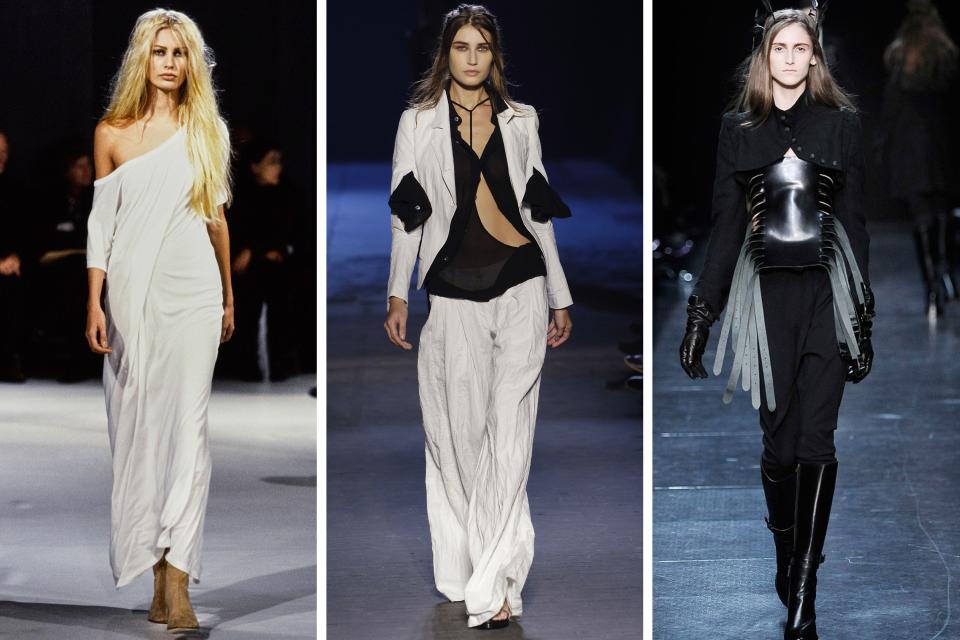
Ann Demeulemeester
Astrologically speaking, Ann Demeulemeester is a fire sign, but her designs were a heady mix of earth and air. One of two female designers that formed part of the Antwerp Six—a loosely configured group of graduates from the Royal Academy of Fine Arts in Antwerp who jolted the fashion system with their alt, deconstructivist vision in the late ’80s—the designer retired from the industry in 2013, leaving behind a legacy that spoke to iconoclasts who approached life with a bit of rebellion. Demeulemeester worked almost exclusively in black and white. The severity of her palette was balanced by the ease of her “she’s come undone” draping, which she often paired with military-style suiting. Accessories ranged from combat boots to feathered crowns.
While Demeulemeester’s deconstructions read as Belgian, her Goth sensibility was connected, via her muse Patti Smith, to New York’s late 1970s punk scene. Her nonconformist approach never wavered and was imminently resistant to trends. As Vogue noted sagely in 1997, “Ann Demeulemeester creates clothes that tell the story of the people who wear them.”—L.B-P.
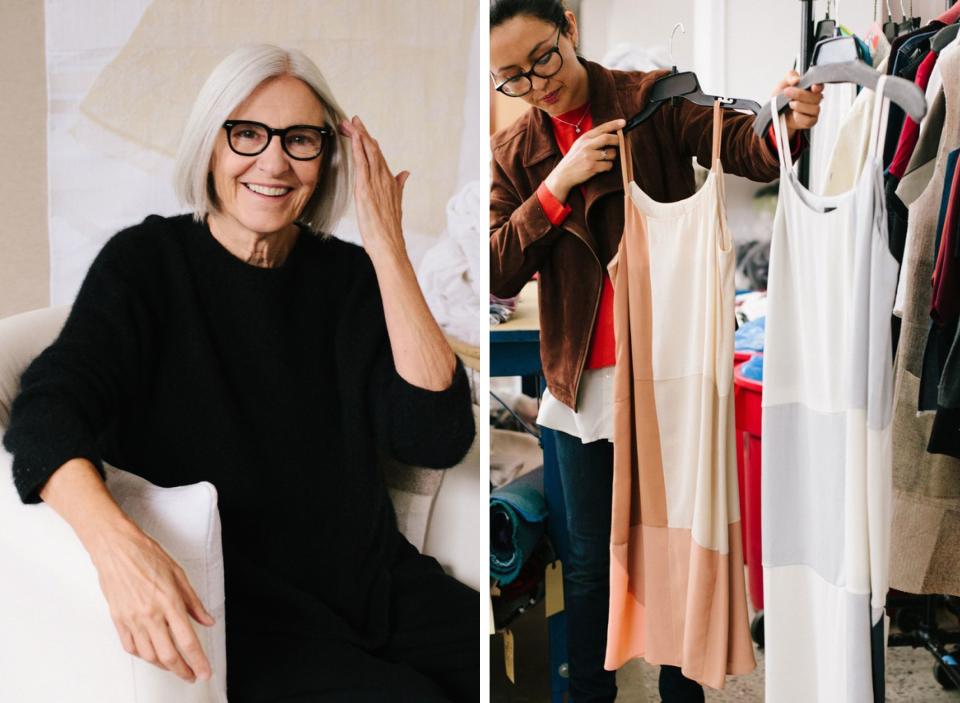
Eileen Fisher
For a long time, highbrow minimalism, with its cream cashmere and eggshell linen, was the purview of the ultrarich or ultrarefined, the go-to aesthetic for the woman who packs just seven items in her suitcase because she can afford the very best: bodysuits from Wolford, pullovers from Loro Piana, etc. The democratization of this style is Eileen Fisher’s greatest contribution to fashion. In malls around America, Fisher’s vision of unfussy elegance has outlived chain stores and fast fashion, weathering the booms and busts of the retail market. Hers is an accessible luxury, one which promises that you too can have the anxious-but-sunny disposition of a Nancy Meyers heroine perched over a kitchen island, cashmere wrap flung over shoulders, sauv blanc in hand. That’s its own kind of American dream.
But that’s just half her story. Over the past 30 years, Fisher has established some of the most aggressive recycling programs in fashion. Her Tiny Factory, located in Irvington, New York, collects old Eileen Fisher products and upcycles them into new garments. Items that can’t be upcycled are placed into a felting machine that makes home textiles and wall hangings. These practices are meant for sharing. “We welcome anyone who’s interested, any way we can share what we know. It’s basically a pre-competitive concept. This idea of sustainability should be for everyone.” — S.Y.
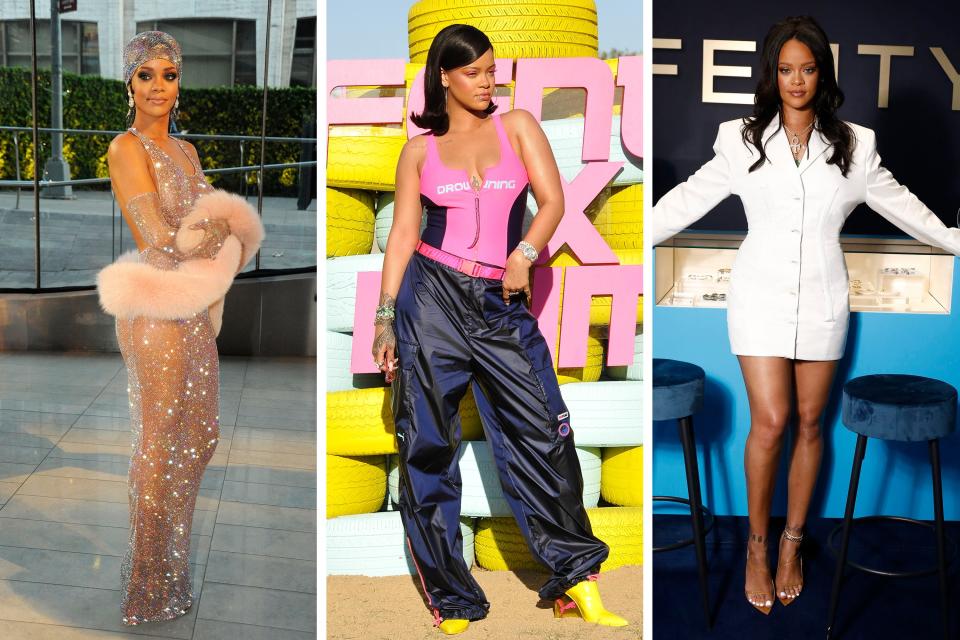
Rihanna
Let’s start with the obvious: We all want to be like Rihanna. Sexier. More confident. Able to walk into a room and suck the air right out. The good news is, unlike many of her other pop star peers, Rihanna wants to share a little bit of this stardust with us. Becoming Rihanna, as she presents it, is an open-source code. With Fenty x Puma, she taught us to step into her stilettoed sneakers and second-skin bodysuits. With Fenty Beauty, she gives us a bit of her interstellar glow. With Savage X Fenty, she makes sure that we can feel just as strong as she does while slipping into something sexy, revealing, and risqué. And now there’s Fenty, her nascent brand with LVMH. It’s cracked open the world of Rihanna’s style, offering suiting, dresses, sunglasses, shoes, and jewelry—the total Rihanna package.
The biggest gamble for a brand that emulates the style of a single person is always: Will the public bite? But here’s the brilliance of the Rihanna way: We already have. When she wore a see-through, crystal-studded “naked dress” to the 2014 CFDA Awards, we bought close approximations. When she went without pants with her Vetements hoodie, we burned our trousers. When she carried a wine glass like a clutch, well, we tried. With her own brand, she has cut out the middleman and begun speaking direction to her legions of fans—#Navy—telling us about her obsessions and styling tricks, promising we can do the same. It’s not Rihanna’s world and we’re just living in it; it’s our world and we’re Rihannafying it together. — S.Y.

Phoebe Philo
Testament to the lasting influence of Phoebe Philo is the fact that going on two years since she walked out the door at Céline, the industry can’t stop talking about her: what she’s up to, if and when she might reemerge, and what we’d like—love—her to do next. The same thing happened when she left Chloé in the mid-’00s. Think about it: Twenty-odd years into the creative director system that shuttles brand name talents in and out of the big European houses, few designers have nailed the zeitgeist twice. Philo did.
Chalk up that phenomenal global success to her intuitive, sensitive approach. Like many of the great names on this list, Philo designs for herself. At Chloé, that meant the sexy, unaffected effortlessness of bottom-hugging flares, Victorian military jackets, wispy camisoles, silk plissé goddess dresses, and, finally, the A-line ’60s shifts that produced a thousand knock-offs before her exit. A few years later she reappeared at Céline, proposing an arty-intellectual strain of minimalism tailored to not just to her new maturity—she was now a mom of three—but also to the straitened times. Her Céline was a hit from the word go, producing a handful of It bags, sparking a Birkenstock craze that’s still ongoing, and launching trends straightforward (white boots) and sublime (modest dressing wouldn’t be the thing it is without Philo). What will she do next? We’ll be watching. —N.P.
Originally Appeared on Vogue

